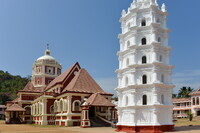Shanta Durga Temple
Chhattrapati Shahu (Shahuji I)

Download1A2-IN-G-ST-A04_cp.jpg (364.7Kb)
Alternate file
Date
1730-1738Description
Overall view with deep stambha (lamp tower) at right and temple at left; A large temple complex 33 km (21 mi) from Panaji at the foothill of Kavalem village. The foundation stone was laid in 1730 and the temple was completed in 1738 (during the reign of Maratha ruler Chhatrapati Shahu of Satara) and renovated in 1966. The temple is dedicated to Shantadurga, the goddess (a form of Parvati) who mediates between Vishnu and Shiva. It is a fusion of Indo-Portuguese architecture. One feature that marks Goan Hindu temple style is the modification of the lat or stambha pillar into a "lamp tower" (deep stambha) that can be lit with traditional oil lamps (diya). The example at the Shanta Durga temple is typical, as described by Jose Pereira: "a polygonal (octagonal) structure, with the corners of the polygons marked by engaged columns, the space between them being occupied by niches for lamps, and the whole crowned by an entablature surmounted by finials." These were influenced by Portuguese and Western architecture. Source: Wikipedia; http://en.wikipedia.org/wiki/Main_Page (accessed 8/25/2015)
Type of Work
temple; lat (pillar)Subject
deities, Hinduism, Maratha Empire, Portugal, colonies, Eighteenth century, Indo-Portuguese
Rights
Rights Statement
Licensed for educational and research use by the MIT community only